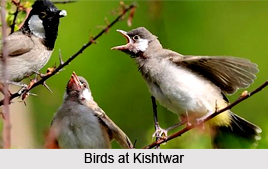 Kishtwar National Park is a beautiful national park which is existent in Kishtwar District of the state of Jammu and Kashmir and is surrounded by Kibar Nala catchment area towards the south, Rinnay River in the north, Marwa River towards its western end and the divide of the Great Himalayas in its eastern side. It was proclaimed a national park on 4th February, 1981 and occupies an area of about 400 square kilometres. The park is based at an altitude measuring about 1, 700 metres to 4, 800 metres close to the Central Crystalline region of the Great Himalayas. The several kinds of flora and fauna present within the premises of Kishtwar National Park enhance the natural charm of this wildlife reserve.
Kishtwar National Park is a beautiful national park which is existent in Kishtwar District of the state of Jammu and Kashmir and is surrounded by Kibar Nala catchment area towards the south, Rinnay River in the north, Marwa River towards its western end and the divide of the Great Himalayas in its eastern side. It was proclaimed a national park on 4th February, 1981 and occupies an area of about 400 square kilometres. The park is based at an altitude measuring about 1, 700 metres to 4, 800 metres close to the Central Crystalline region of the Great Himalayas. The several kinds of flora and fauna present within the premises of Kishtwar National Park enhance the natural charm of this wildlife reserve.
Flora of Kishtwar National Park
Meadows, Coniferous Forests, Scrub Forests and Alpine Forests are amongst the most significant vegetation of the Kishtwar National Park while the types of trees growing here undergo an alteration with height.
 At a height of about 2, 400 metres to 3, 000 metres, different species of Pine trees can be noticed, while at lower altitudes measuring about 1, 700 to 2, 400 metres, Blue Pine, Cedar and Temperate Deciduous Forests thrive and involve other trees like Poplar, Maple, Walnut, Bird Cherry, Yew, Horse-chestnut and others. Silver Fir and Birch are some of the most prominent trees at an altitude between 3,000 to 3,700 metres.
At a height of about 2, 400 metres to 3, 000 metres, different species of Pine trees can be noticed, while at lower altitudes measuring about 1, 700 to 2, 400 metres, Blue Pine, Cedar and Temperate Deciduous Forests thrive and involve other trees like Poplar, Maple, Walnut, Bird Cherry, Yew, Horse-chestnut and others. Silver Fir and Birch are some of the most prominent trees at an altitude between 3,000 to 3,700 metres.
Fauna of Kishtwar National Park
Kishtwar National Park provides refuge to over 15 species of mammals which comprises the Himalayan Brown Bear, Black Bear and Musk Deer. The Hangul which is also known as the `Kashmiri Stag` is one of the renowned animals of this park. This creature arrives here during the winter season all the way from Dachigam National Park and returns back to its abode after the cold season concludes. Wild Boar, Ibex, Serow, Rhesus Macaque, Bharal, Markhor, Leopard, Indian Muntijal and nearly 50 species of birds are existent in Kishtwar National Park. Some of the wonderful birds which reside in the park consist of Golden Oriole, Griffon Vulture, Himalayan Jungle Crow, Indian Myna, Paradise Flycatcher, Bearded Vulture, White Cheeked Bulbul and so on.
The best time to pay visit to this famous national park is from September till March if one looks forward to catching sight of mammals and if people make an attempt to view birds, they must approach the park in the period between March to May.



















